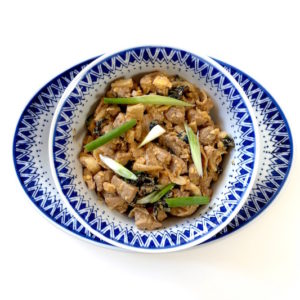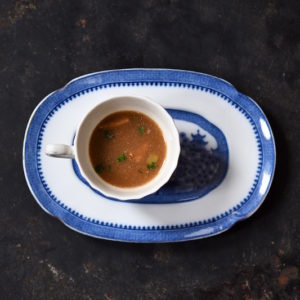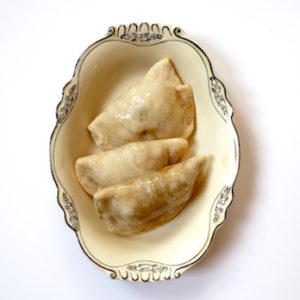Velvet Pork Pie
As the new year begins with its resolutions to diet, go vegan, or otherwise engage in punishing cleanses, the IK brings you meatloaf, Chinese style.

Meatloaf, aka velvet pork pie, isn’t very exciting, but sometimes not very exciting is good. I mean, I don’t know about you, but around here, a little not very exciting would be welcome.

Besides, not very exciting need not equal stodge. One cannot live a life of oh…duck fat washed Armagnac. [This is a thing. I did not make it up.]
Velvet pork pie comes to us courtesy of the late Barbara Tropp. Tropp was chef-owner of San Francisco’s China Moon restaurant and author of two acclaimed books, The Modern Art Of Chinese Cooking and China Moon Cookbook.

Tropp was an uncommonly beloved woman whose name always appears with endearments. In The Perfect Scoop, David Lebovitz describes her as “just absolutely lovely to be around in every respect.” The late Barbara Kafka, known as a tough taskmaster, called Tropp as “one of my favorite people.” [Soup: A Way Of Life]

Indeed, The Modern Art Of Chinese Cooking makes delightful reading even if one’s idea of cooking involves boxes and microwaves; Tropp, a nice Jewish girl from New Jersey, is reminiscent of Laurie Colwin, another nice Jewish girl [albeit from Philadelphia] who died far too young, leaving her bereft readers longing for more.

Velvet Pork Pie [Chinese-style meatloaf]
Adapted slightly from Barbara Tropp’s The Modern Art Of Chinese Cooking, with help from Carolyn Phillips’s All Under Heaven
prep time: about ten minutes to assemble and forty minutes to steam
serves: 2-3 people
* denotes resting places in recipe.
This recipe calls for a steamer. I use a cheap lidded wok bought from Goodwill. My steamer rack comes from 99Ranch Market. Any wide, shallow pot that will hold a rack and nine-inch [22cm] bowl will work.
Lacking a steamer rack, you can use an upturned metal bowl, so long as the bowl’s base stands above the water level and comfortably supports the meatloaf bowl. Other rack options include heat-proof plates or cake racks propped on empty tin cans or crumpled tinfoil.
To ensure the steamer doesn’t run dry [it may require additional water during cooking], toss two or three coins into the pot. They should rattle merrily throughout the cooking time. Thanks to Carolyn Phillips for this trick.
For a discussion of Szechuan pickle and alternatives, see notes, below.
1 tablespoon Szechuan pickled vegetable, well-rinsed and finely chopped [see notes, below]
1 scallion, trimmed and finely chopped
1 garlic clove, crushed, peeled, and minced
approximately 1/2 teaspoon fresh ginger, peeled and minced
2 teaspoons regular soy sauce
2 tablespoons Shaoxing rice wine [or dry sherry]
1/2 teaspoon salt
1 teaspoon ground black pepper
1 generous pound/464 grams ground pork, not lean
about 1/2 teaspoon sesame oil, for oiling steaming bowl
You will need a steamer to prepare this recipe. See discussion of steamers, above. You will also need a bowl to mix the meatloaf and an eight or nine inch [22-23 cm] heat-proof bowl that fits inside your steamer.
Rinse the pickled the vegetable thoroughly. Pat dry. Mince it.
*
Mince the scallion, ginger, and garlic.
*
Mix the pickled vegetable, scallion, garlic, ginger, soy sauce, rice wine, salt, pepper, and pork in the bowl, forming a slightly mounded ball.
Wash your hands well. Rub the clean bowl with the sesame oil. Place the pork in the bowl.
Set the rack in the steamer, set the bowl of pork on the rack, and fill the steamer with warm water–tap water is fine–leaving 3/4 inch [2cm] gap between the water level and the bottom of the bowl. Add your coins, place the lid on the pot, and crank the heat up to high. When the coins start rattling, turn heat down slightly–you want a high heat–and allow pork to steam for 30 minutes, checking the water level if the coins get quiet.
If the coins get quiet before that, do check the water level. You don’t want to ruin your pan, or your meal. Avert your face when lifting the steamer lid. When I prepare this dish, I find it needs additional water at least once, for a total of about 40 minutes cooking time.
To check for doneness, insert a chopstick or skewer into the meat. If the juices run clear, it’s done. If they run red, replace the lid and steam 5-10 more minutes.
Serve velvet pork pie with any stir-fried greens–bitter vegetables like bok choy, broccoli rabe, and bittermelon are especially delicious here–along with your favorite Asian noodles or rice. Copious amounts of Sriracha sauce are a must, as far as I’m concerned.
Leftovers are delicious at any temperature, and the juices exuded during cooking are heavenly in a cross-cultural sandwich.
While velvet pork pie will keep nicely for a few days, refrigerated, it never lasts that long in my house. Velvet pork pie freezes, well wrapped, for up the three months.
Notes:
Szechuan pickled vegetable is sold in foil packets in Asian markets. Feel free to omit it; Tropp suggests substituting soaked, minced dried shrimp, dried black mushrooms, soaked and chopped, fresh peas, fresh water chestnuts [in season as I write], minced scallions, or Chinese chives.
Instead of ground pork, you can use pork shoulder and grind it yourself, using a food processor or two sharp knives.
Non-pork eaters may prepare this recipe using ground beef, chicken, or turkey. (This is not very Chinese. Then again, neither am I.) Be sure the meat is not lean, or the results will be inedibly dry.
Not velvet pork pie. Instead, Sebastopol, California, where we spent New Year’s Eve.





